I am using an EditText under the Material Design and I am having problems in screen orientation. I was able to save the content onSavedInstanceState and reinstate back what was written on edittext back again but there seems to be a bug-like behavior going on.
Look at these following pics:
Original orientation when activity start:

When I rotate the screen, I still get a hold of the content but when I place the carret on an existing text span, it returns the carret to 0 (Beginning of edit text) and then when I typed something it looks like this:
I encountered this situation once and that was very long time ago. IIRC I was able to solve it by completely replacing the content onCreateView's savedInstanceState, it doesn't seem to work anymore.
Any ideas?
[EDIT] A lot of people will be expecting to answer "ONCONFIGURATIONCHANGED". No please, this is not merely the solution for the underlying problem. In fact, I tried it and didn't work, don't want to implement that solution anyways. I believe this doesn't warrant band aid solution, at least as a last resort.
Read the answer to this: Why not use always android:configChanges=“keyboardHidden|orientation”?
Here is my layout file for the 'Fragment' containing the edit text:
<?xml version="1.0" encoding="utf-8"?>
<android.support.design.widget.CoordinatorLayout
xmlns:android="http://schemas.android.com/apk/res/android"
xmlns:app="http://schemas.android.com/apk/res-auto"
xmlns:tools="http://schemas.android.com/tools"
android:layout_width="match_parent"
android:layout_height="match_parent"
android:fitsSystemWindows="true"
android:orientation="vertical"
tools:context=".HomeScreenActivity"
android:weightSum="1">
<android.support.design.widget.AppBarLayout
android:id="@+id/appbar_note"
android:layout_width="match_parent"
android:layout_height="wrap_content"
android:theme="@style/ThemeOverlay.AppCompat.Dark.ActionBar"
android:fitsSystemWindows="true">
<android.support.design.widget.CollapsingToolbarLayout
android:id="@+id/collapsingtoolbarlayout_note"
android:layout_width="match_parent"
android:layout_height="match_parent"
app:layout_scrollFlags="scroll|exitUntilCollapsed"
app:expandedTitleMarginStart="48dp"
app:expandedTitleMarginEnd="64dp">
<android.support.v7.widget.Toolbar
android:id="@+id/toolbar_note"
android:layout_width="match_parent"
android:layout_height="?attr/colorPrimary"
app:popupTheme="@style/ThemeOverlay.AppCompat.Light"
app:contentInsetLeft="0dp"
app:contentInsetStart="0dp"
app:layout_collapseMode="pin">
....
</android.support.v7.widget.Toolbar>
</android.support.design.widget.CollapsingToolbarLayout>
</android.support.design.widget.AppBarLayout>
<android.support.v4.widget.NestedScrollView
android:layout_width="match_parent"
android:layout_height="fill_parent"
android:fillViewport="true"
app:layout_behavior="@string/appbar_scrolling_view_behavior">
<LinearLayout
android:layout_width="match_parent"
android:layout_height="match_parent"
android:orientation="vertical">
<EditText
android:id="@+id/edittext_note"
android:layout_width="match_parent"
android:layout_height="0dp"
android:layout_weight="6"
android:gravity="top"
android:freezesText="true"
android:layout_marginLeft="16dp"
android:layout_marginStart="16dp"
android:layout_marginEnd="16dp"
android:layout_marginRight="16dp"
android:layout_marginTop="16dp" />
<include
layout="@layout/layout_rte_toolbar_black_icon"
android:layout_width="match_parent"
android:layout_height="0dp"
android:gravity="bottom"
android:layout_weight="0.60"/>
</LinearLayout>
</android.support.v4.widget.NestedScrollView>
</android.support.design.widget.CoordinatorLayout>
Next here is my Activity layout, a very simple layout actually:
<FrameLayout
xmlns:android="http://schemas.android.com/apk/res/android"
xmlns:app="http://schemas.android.com/apk/res-auto"
xmlns:tools="http://schemas.android.com/tools"
android:id="@+id/framelayout_note"
android:layout_width="match_parent"
android:layout_height="match_parent"/>
Here is create method callback for Activity:
@Override
protected void onCreate(Bundle savedInstanceState)
{
super.onCreate(savedInstanceState);
Log.i("NoteActivity.OnCreate" , TAG);
setContentView(R.layout.activity_note);
NoteFragment fragment = NoteFragment.createInstance();
fragment.setOnToolbarButtonSelected(this);
getSupportFragmentManager()
.beginTransaction()
.add(R.id.framelayout_note , fragment)
.commit();
}
Here is the create/onSavedInstanceState method callback for the fragment
@Override
public void onCreate(Bundle savedInstanceState)
{
super.onCreate(savedInstanceState);
Log.i("NoteFragment.onCreateView", TAG);
if(savedInstanceState != null)
{
mTitle = savedInstanceState.getString(KEY_EDITTEXT_TITLE, TAG);
mContent = Html.fromHtml(savedInstanceState.getString(KEY_EDITTEXT_CONTENT, TAG));
}
mNoteDataController = ((NotifireApplication) getActivity().getApplication()).getNoteDataController();
setHasOptionsMenu(true);
setRetainInstance(true);
}
@Override
public View onCreateView(LayoutInflater inflater , ViewGroup parent, Bundle savedInstanceState)
{
Log.i("NoteFragment.onCreateView", TAG);
View view = inflater.inflate(R.layout.fragment_note, parent, false);
mNoteContent = (EditText) view.findViewById(R.id.edittext_note);
mNoteTitle = (EditText) view.findViewById(R.id.edittext_note_title);
if(mContent != null) mNoteContent.setText(mContent);
if(mTitle != null) mNoteTitle.setText(mTitle);
initToolbar(view);
return view;
}
@Override
public void onSaveInstanceState(Bundle savedInstanceState)
{
Html.toHtml(mNoteContent.getText());
savedInstanceState.putString(KEY_EDITTEXT_CONTENT, Html.toHtml(mNoteContent.getText()));
savedInstanceState.putString(KEY_EDITTEXT_TITLE, mNoteTitle.getText().toString());
super.onSaveInstanceState(savedInstanceState);
}
